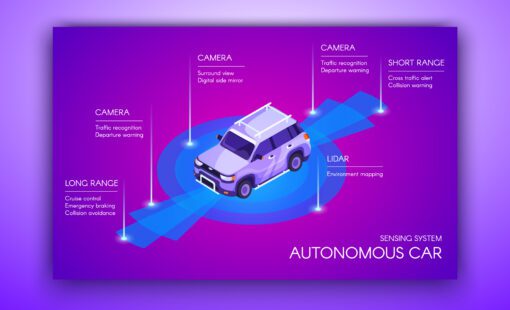Taking a digital engineering approach to manufacturing—one composed of architecture-driven and model-based engineering—offers significant advantages (not to mention tangible benefits both in terms of time and costs). Yet, change is never easy. How can engineering executives ease the transformation? This Survival Guide to Digital Engineering will help create a path to success.
Decisions, decisions
Today’s executives find themselves in a challenging position. Most realize the complexity of electrical/electronic (E/E) systems in today’s products is growing exponentially. With that complexity comes a plethora of issues that will manifest themselves at critical points during the product development process. So, it’s only natural that executives would try to mitigate those often-costly roadblocks by changing key workflows or processes.
Yet, change, by its very nature, tends to be disruptive. If you don’t approach improvements in the right way, you might not see the gains you hoped to achieve. In fact, you might even make it more difficult for your organization to hit all those tricky-to-fulfill requirements while remaining on schedule. Many manufacturers end up disrupting themselves as they try to adopt improvements.
Digital engineering approaches can help balance the tension between increasingly complex systems and tightened production schedules. But which approach is the right fit?
This post will consider the people, process, and technology changes associated with digital engineering approaches, providing a survival guide to help you along the way. We will detail some of the prime considerations your company should take into account before making any significant investments in digital engineering.
What is the cultural fit?
In my 25-year career covering technology-led initiatives, I’ve learned that the biggest obstacle to change is seldom the lack of capabilities in a technological solution. Rather, the most common barrier to successfully adopting a new effort comes down to cultural change.
You can document an outstanding process that project managers are ready to implement. You can select, customize, and deploy an excellent technical solution. However, if you cannot manage and support the changes to your organization’s culture, your initiative will likely fail, no matter how foolproof your technical roadmap appears.
How might you assess whether your organization would adapt well to change? Consider the following:
- How ingrained are your current processes in your people’s day-to-day work and routines? The longer you’ve used the same processes—which become habitual over time—the more challenging it is to make changes.
- What are the differences between current processes and how you’d like to do them in the future? Significant, revolutionary changes are harder to implement. Smaller, evolutionary adjustments make it easier for your team to adapt.
- What is the change in your team’s workload? Where do they benefit? If you ask your staff to work longer and harder, then you will find it hard to motivate them without some tangible gain.
Make no mistake: Managing cultural change is vital to any improvement effort. Make sure to address it early and often throughout your adoption of a digital engineering approach.
Is the plan to change clear?
Realizing value from any new technology-led initiative requires far more than simply installing some additional software. As noted earlier, there are always people, process, and technology aspects required to sustain any new effort. It is essential to build a clear plan detailing how the organization will get from the status quo to the new way of doing things.
Therefore, without such a plan in place—one that you have clearly communicated to your team—those tasked with executing the day-to-day work of product development will be left to troubleshoot and solve any unexpected issues on their own. The lack of clarity about how to do things will cause confusion and frustration. And therefore too often, the easiest way to address any obstacles is just to go back to the old way of doing things.
So how can you provide clarity on your plan? Any transition plan should include the following elements:
- Identify the resources that can help solve potential problems. Undoubtedly, there will be surprises as your organization embarks on improvement efforts. People need to know where to go to resolve competing or conflicting objectives.
- Document and disseminate the sequence of process steps people must follow to execute the new way of doing things. In other words, make this information clear, accessible, and detailed.
- Develop a steady cadence of supportive communication to help reinforce the value of these changes at all levels. Include information about the tactical execution of your improvement effort, the advantages of these changes, and the overall benefits to the product development process.
Give the people who will need to change their work habits guardrails, signs, and instructions to support and reinforce their new workflows. This step is essential to your success.
What is the technological change?
Certainly, in modern product development, technology plays a decisive and enabling role in your execution. There are inherent advantages and disadvantages to any approach you might undertake. What’s most important is that you understand those differences and settle on a set of information technology (IT) applications and systems before pursuing any change. Applying all your outdated technologies to a new process is likely to undermine any potential gains.
How might you mitigate your risks on the technology front? Consider the following actions:
- Educate yourself on the different capabilities provided by various classes of technology solutions and how they might benefit your company’s digital engineering vision. Then, make sure to think about the small-scale change of the first steps involved.
- Identify how your company will migrate data, models, and information to the new platform from older systems and older supporting technology. It’s exceedingly rare that product development projects start from scratch. You’ll need to reuse some legacy designs, which means needing to access and use data from older systems.
- Clearly map out the digital definitions for use in each phase of the product development process. How will teams use and leverage them step by step? Identify when data may need to be manually transitioned or converted. These activities come with a high risk of human error and duplication of efforts.
New technology can enable the changes you wish to see across product development. Positioning those investments correctly within the context of any new digital engineering approach is key to success.
Practicing change management
Manufacturers must balance the tension between the increasing complexity of new product designs and condensed development schedules. More and more, they are looking to digital engineering approaches, including architecture-driven engineering and model-based engineering, to improve the product development process.
However, to make the most of these investments, companies must keep a firm hand on the rudder from the very start. That includes considering cultural fit, clearly communicating plans for change to all stakeholders, and investing in the right technology platforms to support improvements. By adopting effective change management practices and improvements, the integration of new digital engineering approaches will go more smoothly at every organization level.
In our next posts in this series, we’ll start applying these considerations to specific aspects of a digital engineering initiative. Stay tuned.
—–
For more information about digital engineering, architecture-driven engineering, and model-based engineering, visit our website or download our Digital Engineering eBook.
Related Products and Resources

- Webinar

- Blog

- 2020 Technical Webinars
This webinar will explore the Digital Thread within the Digital Engineering process. The Digital Thread is the communication foundation underlying the collaboration and decision-making processes. With a focus on electrical and electronic design processes, this webinar will consider how the Digital Thread can support an MBSE based design process including design review and requirement verification.

- White Paper
This eBook describes an MBSE based process for Electrical and Electronic design. The eBook begins with model content and structure with the purpose of implementation and the need for a “design envelope”.





